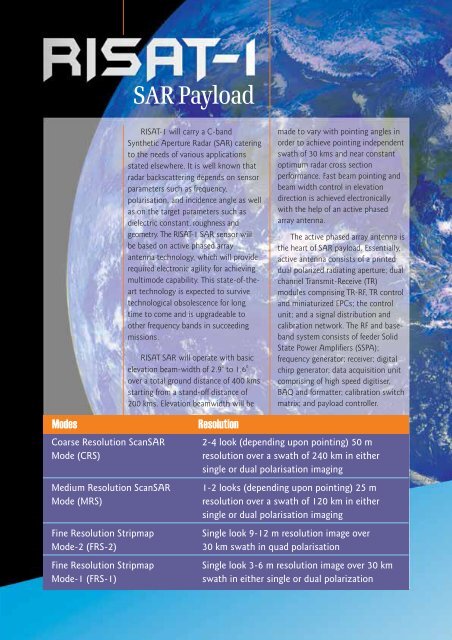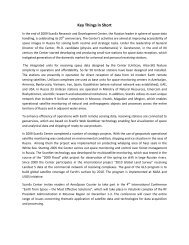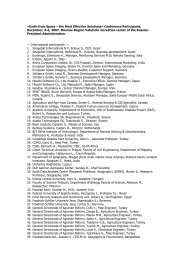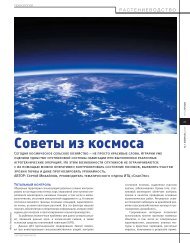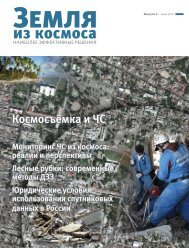RISAT-1. Radar Imaging Satellite
RISAT-1. Radar Imaging Satellite
RISAT-1. Radar Imaging Satellite
Create successful ePaper yourself
Turn your PDF publications into a flip-book with our unique Google optimized e-Paper software.
Modes<br />
Coarse Resolution ScanSAR<br />
Mode (CRS)<br />
Medium Resolution ScanSAR<br />
Mode (MRS)<br />
Fine Resolution Stripmap<br />
Mode-2 (FRS-2)<br />
Fine Resolution Stripmap<br />
Mode-1 (FRS-1)<br />
SAR Payload<br />
<strong>RISAT</strong>-1 will carry a C-band<br />
Synthetic Aperture <strong>Radar</strong> (SAR) catering<br />
to the needs of various applications<br />
stated elsewhere. It is well known that<br />
radar backscattering depends on sensor<br />
parameters such as frequency,<br />
polarisation, and incidence angle as well<br />
as on the target parameters such as<br />
dielectric constant, roughness and<br />
geometry. The <strong>RISAT</strong>-1 SAR sensor will<br />
be based on active phased array<br />
antenna technology, which will provide<br />
required electronic agility for achieving<br />
multimode capability. This state-of-theart<br />
technology is expected to survive<br />
technological obsolescence for long<br />
time to come and is upgradeable to<br />
other frequency bands in succeeding<br />
missions.<br />
<strong>RISAT</strong> SAR will operate with basic<br />
0 0<br />
elevation beam-width of 2.9 to <strong>1.</strong>6<br />
over a total ground distance of 400 kms<br />
starting from a stand-off distance of<br />
200 kms. Elevation beamwidth will be<br />
Resolution<br />
made to vary with pointing angles in<br />
order to achieve pointing independent<br />
swath of 30 kms and near constant<br />
optimum radar cross section<br />
performance. Fast beam pointing and<br />
beam width control in elevation<br />
direction is achieved electronically<br />
with the help of an active phased<br />
array antenna.<br />
The active phased array antenna is<br />
the heart of SAR payload. Essentially,<br />
active antenna consists of a printed<br />
dual polarized radiating aperture; dual<br />
channel Transmit-Receive (TR)<br />
modules comprising TR-RF, TR control<br />
and miniaturized EPCs; the control<br />
unit; and a signal distribution and<br />
calibration network. The RF and baseband<br />
system consists of feeder Solid<br />
State Power Amplifiers (SSPA);<br />
frequency generator; receiver; digital<br />
chirp generator; data acquisition unit<br />
comprising of high speed digitiser,<br />
BAQ and formatter; calibration switch<br />
matrix; and payload controller.<br />
2-4 look (depending upon pointing) 50 m<br />
resolution over a swath of 240 km in either<br />
single or dual polarisation imaging<br />
1-2 looks (depending upon pointing) 25 m<br />
resolution over a swath of 120 km in either<br />
single or dual polarisation imaging<br />
Single look 9-12 m resolution image over<br />
30 km swath in quad polarisation<br />
Single look 3-6 m resolution image over 30 km<br />
swath in either single or dual polarization


